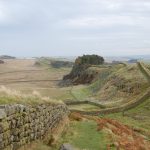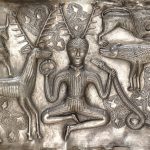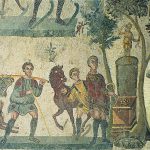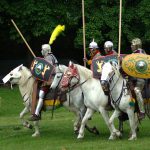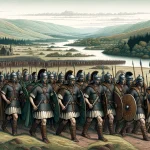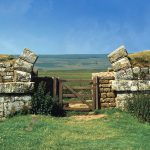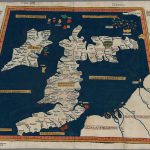Leintwardine (Bravinium) Roman Settlement
Major Settlement and Supply Depot
The major Roman settlement of Bravonium underlies the present village of Leintwardine in Hereford & Worcester, near the confluence of the river Clun with the river Teme, on the Roman road now known as Watling Street West. Occupation of the Leintwardine site was established c.70AD, and started as a civil settlement or vicus consisting of shops and dwellings arranged along either side of the road immediately north of the River Teme crossing (the River Teme was forded here, to the immediate west of the present road bridge).
Branogenium refers to a Roman fort roughly ¼ of a mile south of the village.
The construction of a rampart in around 170 AD (ranging up to two metres tall), and still visible in places around Leintwardine, is thought by local historians to be the result of one of two events. The argument currently in retreat is that following a local uprising the settlement was commandeered by the Roman military in c.160AD, whereupon a large fort was erected on the site to house troops removed from the Welsh garrisons. Another line of thought is that the ramparts were built following widespread local unrest to protect the mansio and the baths, which serviced Roman cavalry forts to the north, south and north-west. There exists a Roman praetorium/principia one mile southwest of Leintwardine atop Brandon Hill, believed to have contained a storage depot, regimental HQ, latrines and cookhouse. Aerial photographs as early at the middle 1950s showed circular crop marks within the confines of the hill fort. Much of the site’s earthworks still exist and Brandon Hill remains an impressive sight.
The Romano-British settlement was eventually demolished by fire in the 4th century and probably not reinhabited for at least a couple of hundred years.
Classical References to Leintwardine (Bravinium) Roman Settlement
The first mention of the Roman fort and Romano-British settlement at Leintwardine is given in Geography of Ptolemy of the second century, who calls the town Brannogenium and perhaps mistakenly, assigns the administration of the town to the Ordovices tribe of Mid Wales. Modern research conducted on the defenses of several local hillforts suggests that the Leintwardine complex was situated close to the borders between three native British tribes, in a sort of ‘no man’s land’. These were the Dobunni to the south-east, the Ordovices to the west and the Cornovii in the north-east. It is generally thought that the town came under the civil administration of the last-mentioned tribe.
Further evidence may be found in the Antonine Itinerary, a collection of Roman road routes throughout the empire compiled during the late second century. Towards the end of the Twelfth British Itinerary, entitled “The route from Moridunum (Carmarthen, Dyfed) to Viroconium (Wroxeter, Shropshire)”, there appears a road-station named Bravonio or Bravonium. This station is listed 24 miles from Magnis (Kenchester, Hereford & Worcester) and 27 miles from Viroconium, which places it squarely at Leintwardine.
The final classical reference for Leintwardine’s Roman name is the seventh-century Ravenna Cosmology (R&C#58), which reverts to the earlier spelling of Ptolemy, again naming the town Brano.Genium. The entry is listed between Magnis (Kenchester) and the settlements Epocessa and Ypocessa, both of which are unidentified but may have been in the neighbourhood of Bravonium.
The Meaning of ‘Bravinium’
The name Bravonium, as it appears in the Antonine Itinerary (Iter XII), could be derived from the Welsh/Gaelic word for quern.¹ This suggests that there was either a hill or rock formation here that looked like a quern, or that there were quern quarries nearby.² In the Upper Silurian series, the Leintwardine beds outcrop in the area and these consist of a calcareous sandstone which would have been suitable for making querns of a finer grade than could be obtained from Millstone grit, which was commonly used. Querns of this calcareous sandstone have been found at Viroconium.” (Webster)
- The early Welsh word for ‘quern’ is *brauon (cf. Welsh breuan), here it would need to be coupled with the Romanised place-name suffix -ium .
- No Roman quarries have been positively identified in the area.
Leintwardine is listed in the Domesday Book of 1086 as Lenteurde, and is apparently derived from the name (Welsh/Gaelic) for the River Teme – formerly known as the Lent which means simply ‘torrent, stream’ – coupled with the Old English worth ‘enclosure’, later replaced by worthign ‘enclosed settlement.’ The modern name therefore, means ‘The Enclosed Settlement on the River Lent.’
The Gods of Bravonium
A couple resident in Leintwardine village recently uncovered an inscribed Roman stone in their back garden. The stone had apparently been robbed from the ruins of the original Roman buildings and was used as hardcore for part of a Medieval boundary wall, which had itself been demolished in antiquity. A preliminary survey of the site by archaeologists prior to building work revealed no traces of any Roman post-holes or foundations, but there was ample evidence of Roman occupation, mainly in the form of potsherds and assorted building rubble. A single Roman coin was also found, too corroded to be dated. The site was formerly an orchard, so presumably all of the useable building stones in the area had been grubbed-out in order for the trees to be planted, and perhaps re-used in the foundations and fabric of later structures.
The stone itself appears to have formed part of an altar to the god Iuppiter Optimus Maximus, both the base and the top of which are missing, but we are lucky, however, in that the surviving central portion contains the dedicatory inscription. Part of this inscription has been damaged, probably in the distant past, but possibly by a mechanical excavator during modern construction work. It measures approximately 11½” in height, 12½” deep and in excess of 14″ in width; the entire altar would possibly have stood between 2½ and 3 feet (70-80cm) tall. The stone is depicted at top-right and reconstructed on the left. A transcription of the text with a tentative Latin expansion and English translation are given below.
RIB 3503 - Altar dedicated to Jupiter Optimus Maximus
To Jupiter Best and Greatest, the villagers living at the fort of Veluniate (or Velunias), paid their vow joyful and willing, deservedly Aelius Mansuetus taking care of the matter.
Veluniate / Velunia: The place-name Veluniate is probably an ablative of place, and its nominative form is uncertain; as Velunia, it is the first of the ten civitates located by the Ravenna Cosmography in sequence from east to west across the Forth-Clyde isthmus.
The Bravonium Military Complex
Leintwardine occupies an important commanding position on the Teme Valley route into central Wales. There are many Roman military sites surrounding the settlement, which was itself occupied by the military in the late second century. There were three consecutive permanent forts here. The first was built half a mile to the north-west of the present village at Jay Lane, the second fort was built a mile to the west at Buckton, and the final fort was built on the site of Leintwardine village itself. Bravonium and the neighbouring earlier forts at Buckton and Jay Lane were probably the base of a mobile force of about 500 cavalry (Ala Quingenaria) that patrolled the Watling Street West far to the north and south.
The Forts at Leintwardine
Roman Marching Camps Near Leintwardine
There are three known Roman marching camps in the immediate area of Leintwardine; at Brampton Bryan, Buckton Park and Walford. In addition, about a mile to the south of Leintwardine is the hillfort known as Brandon Camp (SO4072), which was apparently abandoned prior to the Roman occupation of the area and re-used by the Roman military as a storage-depot. Here, the outlines of several Roman granaries were tentatively identified on aerial photographs and subsequently confirmed by excavation. In addition to these nearby camps, there are others a little way north along the Watling Street at Craven Arms and Upper Affcot, also another at Bromfield near Ludlow.
Brandon Camp – Iron-Age Hillfort / Roman Storage Depot
Ten Iron-Age hillforts within ten miles of Bravonium
Also another four within fifteen miles
References for Bravonivm / Branogenivm
- Air Reconnaissance in Britain, 1958-1960 by J.K. St. Joseph in J.R.S. li (1961) p.124 & fig.4;
- Air Reconnaissance in Britain, 1961-1964 by J.K. St. Joseph in J.R.S. lv (1965) p.85;
- The Cornovii by Graham Webster (Sutton, London, 1975 pp.112-3;
- The Roman Forts at Leintwardine and Buckton by S.C. Stanford in the Transactions of the Woolhope Naturalists Field Club xxxix (1968) p.222;
- All of the plans have been oriented with north at the top.
Map References for Bravonivm / Branogenivm
NGRef: SO 403 740 OSMap: LR137/148
Roman Roads near Bravonivm / Branogenivm
Watling Street West: N (6) to Stretford Bridge (Shropshire) Watling Street West: SSW (21) to Magnis (Kenchester, Herefordshire)
Sites near Leintwardine (Bravinium) Roman Settlement
- Jay Lane Roman Fort (1 km)
Claudian Auxiliary Fort (AD 43–54) - Buckton Roman Fort (1 km)
Flavian Auxiliary Fort (AD 69–96) - Brandon Camp Roman Fort (2 km)
Neronian Auxiliary Fort (AD 54–68) - Brandon Camp Hillfort (2 km)
Iron Age Hillfort - Buckton Park Temporary Camp (2 km)
Marching or Temporary Camp - Walford Camp (2 km)
Marching or Temporary Camp - Brampton Bryan Camp (3 km)
Marching or Temporary Camp - Coxall Knoll (4 km)
Iron Age Hillfort - Pyon Wood Camp (8 km)
Iron Age Hillfort - Croft Ambrey Hillfort (8 km)
Iron Age Hillfort and Romano-british Temple Or Shrine
